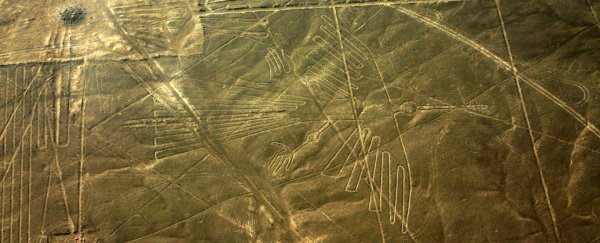Researchers have analysed 100 recently discovered geoglyphs engraved into the Nazca Desert in southern Peru, as well as nearby shards of ancient ceramics, providing new clues about the creators of the mysterious Nazca Lines.
It's believed that the huge, complex engravings, which range from simple geometric line drawings to detailed images of animals and extraterrestrial-looking beings, were created by the native local cultures between 200 BC and 600 AD, but very little detail is known about why they were drawn. The largest Nazca Lines stretch over 200 metres across - something that makes for incredible viewing from above - and are believed to have have religious significance. Remarkably, most of the lines have been naturally preserved over the past 1,500 years due to the dry and windless climate of the elevated desert.
Now, a group of researchers from Yamagata University in Japan have found evidence that suggests that the geoglyphs were created by not just one, but two separate groups of people. And their purpose may have changed over time.
Presenting their research at the annual meeting of the Society for American Archaeology, the team proposed that the earliest Nazca Lines were created so that pilgrims could use the markings along a ritual pilgrimage. But there's evidence that, later on, people may have smashed ceramic pots where the lines intersect as part of localised religious ceremonies.
To work this out, the researchers analysed the style, location and construction method of 100 recently found Nazca Lines. They found that four different styles of the drawings seemed to be grouped together along routes that led to a vast pre-Incan temple complex called Cahuachi. Previous research has suggested that Cahuachi was a spot of religious importance that people journeyed from near and far to bringing gifts and offerings, and the researchers believe that the geoglyphs may have been used along the way to help people navigate.
However, all the different styles were grouped along different routes to the temple, and the researchers found that they were all constructed differently as well, with some created by removing rocks from the middle of the image, and others made with the removal of rocks from the border.
Two of these groups, which the team named type A and B, were found near the Ingenio Valley. "Therefore it seems reasonable to assume that type A and B geoglyphs were drawn by the group from the Ingenio Valley," Masato Sakai, the lead researcher, told Tia Ghose over at Live Science.
They also found a separate style of geoglyphs, which included the mysterious 'supernatural beings', near the Nazca Valley, making it likely that they were made by the people who lived there. A third type of glyphs was found between the two cultures, and the team believes that both these two groups contributed to the creation of these.
Through analysing shards of ceramics found on intersecting points of the Lines, the team also found that, in the years leading up to 200 AD, which archaeologists called the final Formative period, the Nazca Lines may have had a different purpose to those created centuries later.
"Our research revealed that the Formative geoglyphs were placed to be seen from the ritual pathways, while those of the early Nazca period were used as the loci of ritual activities such as intentional destructions of ceramic vessels," Sakai told Ghose. "Even after the collapse of the Cahuachi temple, trapezoids and straight lines continued to be made and used."
There's still a lot we don't know about what these beautiful and mysterious images were used for, but we're definitely getting closer.
